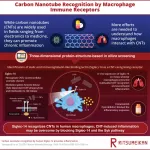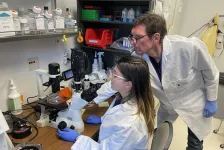(Press-News.org) FOR IMMEDIATE RELEASE
A new drug, a monoclonal antibody known as enoblituzumab, is safe in men with aggressive prostate cancer and may induce clinical activity against cancer throughout the body, according to a phase 2 study led by investigators at the Johns Hopkins Kimmel Cancer Center and its Bloomberg~Kimmel Institute for Cancer Immunotherapy. If confirmed in additional studies, enoblituzumab could become the first promising antibody-based immunotherapy agent against prostate cancer.
In a clinical trial, 32 men with high-risk or very high-risk prostate cancers who were scheduled for prostate cancer surgery were treated with six weekly infusions of enoblituzumab prior to surgery, and were followed for an average of 30 months thereafter. Twenty-one patients, or 66%, had an undetectable prostate-specific antigen (PSA) level 12 months following surgery, suggesting that there was no sign of residual disease. Additionally, the drug was well-tolerated overall; no patients had any surgical delays or medical complications during or after the operation.
A description of the work was published April 3 in the journal Nature Medicine.
If enoblituzumab continues to perform well in further larger randomized studies, it could represent a new pathway for immunotherapy against multiple cancers, and the first one that may have a role for prostate cancer, says lead study author and cancer immunology researcher Eugene Shenderov, M.D., Ph.D., assistant professor of oncology at the Johns Hopkins University School of Medicine. Other existing antibody-based immunotherapy drugs have targeted immune checkpoints, natural on/off switches mediating immune responses, such as CTLA-4, PD-1 and LAG-3. Cancer cells hijack these checkpoints, turning off the immune response to cancer. “Drugs that block these checkpoints have had success in other types of cancers, including lung cancer and melanoma, but not in prostate cancer,” says Shenderov.
Enoblituzumab works by binding to a protein called B7-H3 that is overexpressed on prostate cancer cells and believed to impede the immune system’s ability to attack cancer cells. The new therapy could pack a one-two punch against cancer, Shenderov says, by blocking B7-H3’s inhibition of the immune system’s recognition and elimination of cancer cells, and also triggering a process called antibody-dependent cellular cytoxicity (ADCC), which leads to tumor cell destruction by activating additional immune cells such as macrophages and natural killer cells.
“Enoblituzumab appears safe and seems to activate the immune system in a way that involves both T-cells and myeloid cells,” Shenderov says. “What this means is if these results can be replicated in a larger, randomized study, it opens the possibility that combining this therapy with local, curative-intent therapies like surgical prostate removal or radiation therapy, would allow this drug to potentially kill micrometastatic disease hiding elsewhere in the body, and therefore prevent a significant number of men from experiencing recurring disease. That could be a paradigm shift in prostate cancer.”
The median age of study participants was 64 (age range 48–74). About half (47%) had a PSA greater than 10 ng/mL at diagnosis, which is abnormally high, and 50% had Gleason grade group 5 at biopsy, meaning they had highly aggressive disease. Patients were enrolled from February 2017 through June 2019. Enoblituzumab was confirmed to penetrate into prostate tumors and to bind to B7-H3 in the vast majority of participants, according to prostate samples studied after surgery.
Side effects of enoblituzumab were generally mild and included fatigue, neurological symptoms such as headache or dizziness, and flu-like or cold symptoms. One patient developed inflammation of the heart (myocarditis), which fully resolved with steroid treatment, and is a known side effect of other immune checkpoint drugs.
Beyond safety and anti-tumor activity based on PSA dropping to undetectable levels, investigators also looked for changes in the tumor microenvironment before and after enoblituzumab treatment. They found increased markers of cytotoxicity after treatment, consistent with the concept that the immune system was activated against tumor cells. The tumors showed increased infiltration with granulocytes, leukocytes and effector T-cells, and there was roughly a doubling of the density of cytotoxic T cells after treatment.
“The findings are exciting but exploratory, and need to be confirmed in larger study cohorts,” cautions senior study author Emmanuel S. Antonarakis, M.D., the Clark Endowed Professor of Medicine and director of GU Oncology for the University of Minnesota Masonic Cancer Center. Antonarakis was the senior investigator of the study while he was at the Johns Hopkins Kimmel Cancer Center.
“However, these results in high-risk prostate cancer patients, and the broader need for immunotherapeutic strategies with efficacy in prostate cancers, provide justification to further develop multipronged approaches that include targeting B7-H3 to optimize antitumor activity in prostate cancers and other solid malignancies,” he says.
Investigators are now planning a larger, randomized trial of enoblituzumab in newly diagnosed prostate cancer patients to assess clinical activity of the drug compared to current standards of care.
Coauthors of the current study were Angelo M. De Marzo, Tamara L. Lotan, Hao Wang, Sin Chan, Su Jin Lim, Hogkai Ji, Mohamad El Allaf, Carolyn Chapman, Samuel R. Denmeade, Kenneth J. Pienta, Christian P. Pavlovich, and Drew M. Pardoll of Johns Hopkins. Other study authors contributing to the paper were from MacroGenics Inc. of Rockville, Maryland (the maker of enoblituzumab); NanoString Technologies Inc. of Seattle; Adaptive Biotechnologies of Seattle; CDI Labs of Baltimore; the Northwestern University Feinberg School of Medicine in Chicago; and Charles G. Drake formerly at Johns Hopkins, who currently leads Immuno-Oncology at Janssen Research and Development.
The work was supported by the National Institutes of Health (Cancer Center Support Grant P30 CA006973), an NCI SPORE in Prostate Cancer (P50CA58236), a Prostate Cancer Foundation Young Investigator Award, the Department of Defense (grants W81XWH-16-PCRP-CCRSA and W81XWH-18-2-0015), and the Bloomberg~Kimmel Institute for Cancer Immunotherapy and by Macrogenics Inc, of Rockville, Maryland.
E. Shenderov is a paid consultant to GT Biopharma, Guidepoint Global, FirstThought, GLG, and receives institutional research funding from MacroGenics Inc., manufacturer of enoblituzumab. These relationships are managed by The Johns Hopkins University in accordance with its conflict of interest policies. E. Antonarakis has served as a paid consultant for Janssen, Astellas, Sanofi, Bayer, Bristol Myers Squibb, Amgen, Constellation, Blue Earth, Exact Sciences, Invitae, Curium, Pfizer, Merck, AstraZeneca, Clovis and Eli Lilly; and has received research support from MacroGenics, Janssen, Johnson & Johnson, Sanofi, Bristol Myers Squibb, Pfizer, AstraZeneca, Novartis, Curium, Constellation, Celgene, Merck, Bayer, Clovis and Orion. These relationships are managed by the University of Minnesota (Antonarakis’ current institution) in accordance with their conflict of interest policies.
END
Novel immunotherapy agent safe, shows promise against high-risk prostate cancers
2023-04-06
ELSE PRESS RELEASES FROM THIS DATE:
Fiery response: “Siglec-14” receptors on human macrophages detect carbon nanotubes and provoke inflammation, finds study
2023-04-06
Carbon nanotubes (CNTs) have become a mainstay of the field of nanotechnology. Finding innovative applications across materials science, electronics, and medicine, CNTs have garnered a lot of attention from researchers in recent years. However, the International Chemical Secretariat (ChemSec) has moved to flag CNTs on the “Substitute It Now!” database of chemicals likely to be restricted for use. In fact, due to their persistence in nature and potential toxicity to humans, ChemSec has proposed that adequate assessments of CNTs' risk to human health are urgently needed.
Following their entry into the body, and much like asbestos, CNTs are targeted by the immune system and preferentially ...
Alternative glucose breakdown ensures the survival of cancer cells
2023-04-06
A key enzyme in sugar metabolism is inactivated particularly easily and efficiently by oxidative stress. Scientists at the German Cancer Research Center (Deutsches Krebsforschungszentrum, DKFZ) have now shown that with this oxidation, cells switch to an alternative sugar breakdown pathway and can thus escape oxidative stress. Cancer cells in particular benefit from this mechanism, which can also protect them from therapy-related damage.
One of the central enzymes in sugar breakdown, GAPDH (glyceraldehyde-3-phosphate dehydrogenase), ...
Super-sized nanocage could deliver bigger drug cargoes
2023-04-06
Think about how frustrating it is to try to fit a gift into a box that is too small. Sometimes you just need a bigger box.
Building a bigger box
Nanocages are tiny artificial containers that can be used to deliver therapeutics to a target destination in the body. But some drug molecules are like gifts that are too big for a standard-sized nanocage ‘box’. Now, in an article published today in Nature Synthesis, researchers from the University of Cambridge describe how they have built a super-sized nanocage that could be used to deliver larger drug cargoes. They have built a bigger box.
Simple building blocks
Rational control over the self-assembly of these types of cages generally ...
Shedding light on mechanisms of electrochemical energy storage
2023-04-06
Understanding why certain materials work better than others when it comes to energy storage is a crucial step for developing the batteries that will power electronic devices, electric vehicles and renewable energy grids. Researchers at Drexel University have developed a new technique that can quickly identify the exact electrochemical mechanisms taking place in batteries and supercapacitors of various compositions — a breakthrough that could speed the design of higher performing energy storage devices.
Reported in Nature Energy, the Drexel team’s ...
Researchers tackle major obstacle to stem-cell heart repair
2023-04-06
Researchers at the University of Washington School of Medicine in Seattle have engineered stem cells that do not generate dangerous arrhythmias, a complication that has to date thwarted efforts to develop stem-cell therapies for injured hearts.
“We have found what we have to tackle to make these cells safe,” said Silvia Marchiano, a postdoctoral fellow in the laboratory of Chuck Murry at the UW Medicine Institute for Stem Cell and Regenerative Medicine. Marchiano is the lead author of a paper describing the findings published Thursday, April ...
Twinkling stars fuel interstellar dust
2023-04-06
Of the many different kinds of stars, asymptotic giant branch (AGB) stars, usually slightly larger and older than our own sun, are known producers of interstellar dust. Dusty AGBs are particularly prominent producers of dust, and the light they shine happens to vary widely. For the first time, a long-period survey has found the variable intensity of dusty AGBs coincides with variations in the amount of dust these stars produce. As this dust can lead to the creation of planets, its study can shed light on our own origins.
You’ve probably heard of the James Webb Space Telescope (JWST) which ...
The hidden role of food in urban conflicts in Central America
2023-04-06
Extreme water events have been shown to affect human security in many ways. In a research article published today in the new journal Nature Water researchers from Politecnico di Milano and University of California at Berkeley delve deeper into the complex nexus between droughts and conflicts in Central America. For the decades from 1996 to 2016 explore how water availability affects agricultural production and food security, and investigate the nexus between drought-induced food insecurity and the emergence of conflict in the region. Cities in ...
Fasting diet reduces risk markers of type 2 diabetes
2023-04-06
A fasting diet which focuses on eating early in the day could be the key to reducing the risk of developing type 2 diabetes.
Researchers from the University of Adelaide and South Australian Health and Medical Research Institute (SAHMRI) compared two different diets: a time restricted, intermittent fasting diet and a reduced calorie diet to see which one was more beneficial for people who were prone to developing type 2 diabetes.
“Following a time restricted, intermittent fasting diet could help lower the chances of developing type 2 diabetes,” said ...
Optimizing sepsis treatment timing with a machine learning model
2023-04-06
COLUMBUS, Ohio – A new machine learning model that estimates optimal treatment timing for sepsis could pave the way for support tools that help physicians personalize treatment decisions at the patient bedside, researchers say.
In a paper published today (April 6, 2023) in Nature Machine Intelligence, scientists from The Ohio State University describe the new model, which uses artificial intelligence to take on the complex question of when to administer antibiotics to patients with a suspected case of sepsis.
Time is of the essence ...
How to overcome noise in quantum computations
2023-04-06
Researchers Ludovico Lami (QuSoft, University of Amsterdam) and Mark M. Wilde (Cornell) have made significant progress in quantum computing by deriving a formula that predicts the effects of environmental noise. This is crucial for designing and building quantum computers capable of working in our imperfect world.
The choreography of quantum computing
Quantum computing uses the principles of quantum mechanics to perform calculations. Unlike classical computers, which use bits that can be either 0 or 1, quantum computers use quantum bits, or qubits, which can be in a superposition of 0 and 1 simultaneously.
This ...



